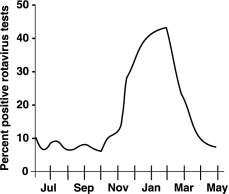A) Fomite.
B) Direct contact.
C) Vehicle transmission.
D) Droplet transmission.
E) Vector.
G) All of the above
Correct Answer

verified
Correct Answer
verified
Multiple Choice
Pseudomonas bacteria colonized the bile duct of a patient following his liver transplant surgery. This is an example of a
A) Latent infection.
B) Nosocomial infection.
C) Sporadic disease.
D) Communicable disease.
E) None of the above.
G) A) and B)
Correct Answer

verified
Correct Answer
verified
Multiple Choice
Which one of the following is not a zoonosis?
A) Cat- scratch disease
B) Tapeworm
C) Hantavirus pulmonary syndrome
D) Rabies
E) None of the above
G) A) and C)
Correct Answer

verified
Correct Answer
verified
Multiple Choice
The most likely mode of transmission of pneumonic plague between humans is
A) Direct contact.
B) Vehicle transmission.
C) Fomite.
D) Vector.
E) Droplet transmission.
G) All of the above
Correct Answer

verified
Correct Answer
verified
Multiple Choice
All of the following statements about biological transmission are true except
A) The pathogen reproduces in the vector.
B) The pathogen may require the vector as a host.
C) The pathogen may enter the host in the vector's feces.
D) Houseflies are an important vector.
E) The pathogen may be injected by the bite of the vector.
G) A) and E)
Correct Answer

verified
Correct Answer
verified
Multiple Choice
Emergence of infectious diseases can be due to all of the following except
A) Antibiotic resistance.
B) Travel.
C) Climatic changes.
D) Digging up soil.
E) Microbes trying to cause disease.
G) A) and B)
Correct Answer

verified
Correct Answer
verified
Multiple Choice
A cold transmitted by a facial tissue is an example of
A) Vehicle transmission
B) Vector
C) Fomite
D) Direct contact
E) Droplet transmission
G) C) and D)
Correct Answer

verified
Correct Answer
verified
Multiple Choice
Koch's postulates don't apply to all diseases because
A) Some microorganisms can't be cultured in laboratory media.
B) Some microorganisms can't be observed.
C) Some microorganisms don't cause the same disease in laboratory animals.
D) Some microorganisms cause different symptoms under different conditions.
E) All diseases aren't caused by microorganisms.
G) C) and D)
Correct Answer

verified
Correct Answer
verified
Multiple Choice
Figure 14.2
 -In Figure 14.2, what is the endemic level of rotavirus infections?
-In Figure 14.2, what is the endemic level of rotavirus infections?
A) 0%
B) Approximately 10%
C) Approximately 20%
D) 35%
E) The month of January
G) B) and E)
Correct Answer

verified
B
Correct Answer
verified
Multiple Choice
Legionellosis transmitted by a grocery store mist machine is an example of
A) Fomite.
B) Vehicle transmission.
C) Droplet transmission.
D) Vector.
E) Direct contact.
G) B) and C)
Correct Answer

verified
Correct Answer
verified
Multiple Choice
Which of the following statements is true?
A) Symbiosis refers to different organisms living together and benefiting from each other.
B) Symbiosis refers to different organisms living together.
C) Members of a symbiotic relationship cannot live without each other.
D) At least one member must benefit in a symbiotic relationship.
E) A parasite is not in symbiosis with its host.
G) A) and E)
Correct Answer

verified
B
Correct Answer
verified
Multiple Choice
A sexually transmitted disease is an example of
A) Vector.
B) Direct contact.
C) Vehicle transmission.
D) Droplet transmission.
E) Fomite.
G) C) and D)
Correct Answer

verified
Correct Answer
verified
Multiple Choice
Which of the following is a fomite?
A) Insects
B) Pus
C) Droplets from a sneeze
D) Water
E) A hypodermic needle
G) C) and E)
Correct Answer

verified
Correct Answer
verified
Multiple Choice
The major significance of Koch's work was that
A) Diseases can be transmitted from one animal to another.
B) Microorganisms are the result of disease.
C) Microorganisms can be cultured.
D) Microorganisms are present in a diseased animal.
E) Microorganisms cause disease.
G) C) and D)
Correct Answer

verified
Correct Answer
verified
Multiple Choice
Symptoms of disease differ from signs of disease in that symptoms
A) Are changes observed by the physician.
B) Always occur as part of a syndrome.
C) Are changes felt by the patient.
D) Are specific for a particular disease.
E) None of the above.
G) A) and C)
Correct Answer

verified
C
Correct Answer
verified
Multiple Choice
Which of the following statements about nosocomial infections is not true?
A) They are caused by normal microbiota.
B) They are caused by opportunists.
C) They are caused by drug- resistant bacteria.
D) They occur in compromised patients.
E) None of the above.
G) B) and C)
Correct Answer

verified
Correct Answer
verified
Multiple Choice
Which of these infections can cause septicemia?
A) Local infection
B) Focal infection
C) Septicemia
D) Bacteremia
E) Systemic infection
G) B) and E)
Correct Answer

verified
Correct Answer
verified
Multiple Choice
Which of the following definitions is incorrect?
A) Epidemic - fraction of the population having a disease at a specified time
B) Pandemic - a disease that affects a large number of people in the world in a short time
C) Endemic - a disease that is constantly present in a population
D) Sporadic - a disease that affects a population occasionally
E) None of the above
G) All of the above
Correct Answer

verified
Correct Answer
verified
Multiple Choice
A needlestick is an example of
A) Direct contact.
B) Vector.
C) Droplet transmission.
D) Vehicle transmission.
E) Fomite.
G) B) and D)
Correct Answer

verified
Correct Answer
verified
Multiple Choice
Mechanical transmission differs from biological transmission in that mechanical transmission
A) Involves fomites.
B) Doesn't involve specific diseases.
C) Doesn't require an arthropod.
D) Requires direct contact.
E) Doesn't work with noncommunicable diseases.
G) B) and D)
Correct Answer

verified
Correct Answer
verified
Showing 1 - 20 of 43
Related Exams